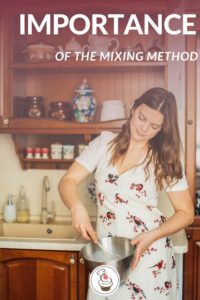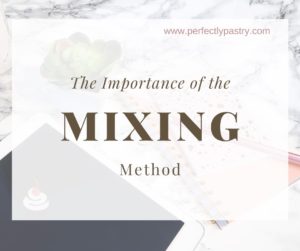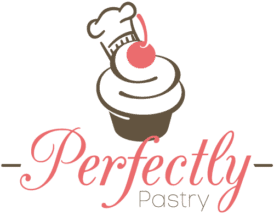We refer to On Baking: 3rd Edition by Labensky, S. et al. as our baking bible. As a matter of fact, we have a paper copy for our pastry chef to make notes, and we have a digital copy to access in the go.
Every baking business needs this book even without a storefront. Almost any question you have can be answered by the book, and it has hundreds of recipes for inspiration.
Today we are going to focus on mixing methods, and why these different techniques are important for you.
**This post may contain affiliate links. If you make a purchase from one of my links, I may receive a commission or credit at no additional cost to you. For more info, please read my disclosure policy.**

What is mixing methods in your baking?
The point of mixing methods in your baking is to accomplish a few different things. The technique in which you mix the ingredients accomplishes different tasks. For example, if you need to combine ingredients, the recipe instructions might tell you to stir, but if you need to incorporate air, then the recipe may call for you to whip the ingredients.
There are 9 different methods for mixing. Each method adds something to your baking process, and each method is accomplished differently.
9 Different Mixing Methods
- Beating
- Blending
- Creaming
- Cutting
- Folding
- Kneading
- Sifting
- Stirring
- Whipping
Take a moment and see if you can think of a time you have used these different methods. Now think about why these techniques were important for the baking process in that specific recipe. Let’s talk about each method, what the purpose of the method is in the baking process, and the tools required for that specific method.
Why These Mixing Methods In Your Baking
- Beating: This is the process of creating air or gluten by quickly mixing ingredients. You accomplish this by using a spoon or the paddle attachment on a mixer.
- Blending: This is used to distribute the ingredients in a batter or mixture evenly. Several tools can be used to blend a mixture. You can use a spoon, rubber spatula, whisk, or the paddle attachment on a mixer.
- Creaming: This is when you incorporate air while combining softened fats and sugar. Use the paddle attachment of the mixer on medium for creaming.
- Cutting: This is done to mix fats into dry ingredients such as butter into pie dough. Depending on your final product, you can cut a mixture with a pastry cutter, your fingers, or the paddle attachment on your mixer.
- Folding: Folding is used to mix delicate ingredients like whipping cream or whipped eggs into a dough or batter. When folding in ingredients, use a rubber spatula or a balloon whisk.
- Kneading: This is done to create gluten in your product. Gluten provides the structure for your finished product. Use a dough hook for kneading. If you must do it by hand, fold vigorously in a rhythm to encourage the gluten forming process.
- Sifting: This process removes lumps from dry ingredients and aerate the ingredients. To accomplish this, my a rotating sifter or mesh strainer.
- Stirring: This is mixing the ingredients by hand using a rubber spatula, spoon, or whisk.
- Whipping: This is when you beat a mixture vigorously to incorporate air. To whip a mixture such as American buttercream icing (grab our delicious recipe here), use the whip attachment for your mixer or whisk.
So, these are how the different methods are used and what tools to use for each method, but it doesn’t help you understand the final result. Let’s talk more about that.

Methods And The Final Results
The purpose of mixing ingredients for a recipe is to accomplish certain goals.
- Distribute the ingredients evenly
- Breakdown and mix fats and liquids
- Activate the formation of gluten
- Incorporate air into the mixture
Depending on your final goal, you may use a few different techniques in your mixing process. Fats can add flakiness to a dough. Gluten is the foundation of dough and can make the product soft or hard, while air creates fluffiness in a product.
It is crazy to think that in a recipe, you not only need to pay attention to the types of ingredients but also you must pay close attention to the mixing method if you want to reach your desired results.
If you really want to dedicate yourself to understanding the science and technique behind baking, then we HIGHLY, HIGHLY suggest you get your own copy of On Baking: 3rd Edition by Labensky, S. et al.
Reference: Labensky, S., et al. (2016). On Baking: 3rd Edition. Pearsons
Want to see how we incorporate these mixing methods into our recipes? Then check out some of the recipes we use in our business.
Holiday Baking Guide
Autumn Baking Guide
Flaky Pie Crust Recipe
Are you ready to grow your business and make more money, but you don’t know if you have your pricing correct? Then we suggest you learn how to “Take Control Of Your Pricing In 3 Days“ with our FREE mini pricing course here. I know you probably don’t think you have time to add anything else to your plate right now.
However, this email course is just one email daily for 3 days. Each email is packed with actionable tips to get comfortable with pricing in your business quickly. If you have your pricing under control, then stop by here to get some ideas on how to grow your baking business. Take these ideas and incorporate them into your current business plan.
Please tell me you have a business plan. I know you are busy, but it is so important for the growth of your business. Go here to learn why it is so important and grab our Blueprint To Building Your Dreams Template here to build your business plan today.



Comments are closed.